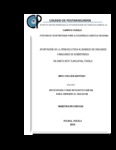| dc.contributor.author | Galván Antonio, Areli. | |
| dc.creator | GALVAN ANTONIO, ARELI; 373839 | |
| dc.date.accessioned | 2015-02-04T23:03:08Z | |
| dc.date.available | 2015-02-04T23:03:08Z | |
| dc.date.issued | 2014 | |
| dc.identifier.uri | http://hdl.handle.net/10521/2550 | |
| dc.description | Tesis (Maestría en Ciencias, especialista en Estrategias para el Desarrollo Agrícola Regional).- Colegio de Postgraduados, 2014. | es_MX |
| dc.description.abstract | Los estudios orientados a entender el funcionamiento de las unidades familiares ganaderas de subsistencia son escasos, por lo que el objetivo de la investigación fue caracterizar las explotaciones ovinas en tres comunidades del municipio de Santa Rita Tlahuapan, Puebla, para detectar su problemática, posibilidades de desarrollo y la composición de su ingreso. Se aplicó un cuestionario a 38 Unidades Familiares de Subsistencia (UFS), se usó estadística descriptiva y para la tipología se seleccionaron variables con las que se realizaron análisis cluster y de varianza para la descripción de grupos. Las UFS en promedio fueron de 4 personas, los productores tienen 55 años, el tiempo en la actividad es de 19 años; los rebaños son de 37 animales de razas criollas y cruzados (Suffolk-Dorper, Hamshire-Dorper). La tipología fue: a) Pequeños productores, b) Productores jóvenes, c) Productores con mayor número de ovinos, d) Productores con la mayor superficie de cultivos y rumiantes. La Matriz de Contabilidad Social Aplicada a Pueblos (MCSP), encontró que la actividad productiva que tiene mayor valor es el comercio con el 47%, seguido de la ganadería con el 27% y al final la agricultura con el 26%. De los tres grupos, los considerados de subsistencia, el dos fue el que percibió mayores ingresos. La problemática de la ovinocultura, se centra en cuestiones sanitarias, alimenticias y de instalaciones deficientes. La MCSP indicó que lo hogares poseen una dependencia de insumos regionales y para desarrollar las actividades productivas es vital la mano de obra familiar. _______________ SHEEP HUSBANDRY CONTRIBUTION TO HOUSEHOLD SUPPORT UNDER SUBSISTENCE CONDITIONS IN SANTA RITA TLAHUAPAN, PUEBLA. ABSTRACT: The studies focused on understanding the functioning of subsistence sheep husbandry carried out by families under subsistence conditions are scanty. Thus, the aim of this research was to characterize the households rising sheep under subsistence conditions in three communities from the municipality of Santa Rita Tlahuapan, Puebla State, Mexico, in terms of their production problems. A questionnaire was applied to 38 family units of subsistence (FUS). Descriptive statistics were used; for the typology construction, variables were selected in order to perform a cluster analysis and later, with the identified groups, an analysis of variance was used. The FUS on average had 4 persons, the producers are 55 years old, and the time dedicated to this activity has been 19 years. The size of flocks is 37 animals integrated by creole and crossed (Suffolk-Dorper, Hamshire-Dorper) breeds. In the typology four groups were identified, a) Small producers, b) young Producers, c) Producers with the highest number of sheep, d) Producers with the largest area of crops and cattle. The Social Accounting Matrix Applied (SAMA) to towns detected that the productive activity with greater value is commerce with 47%; it is followed by animal husbandry with 27% and agriculture with 26%. Of the three subsistence groups, the second had higher incomes. The problems of sheep husbandry are related to health issues, deficient feeding and facilities. The SAMA indicated that households have a dependency on regional inputs and, to develop productive activities, household labor is vital. | es_MX |
| dc.description.sponsorship | Consejo Nacional de Ciencia y Tecnología (CONACyT). | es_MX |
| dc.language.iso | spa | es_MX |
| dc.subject | Ganadería de subsistencia | es_MX |
| dc.subject | Matriz de contabilidad social | es_MX |
| dc.subject | Social accounting matrix | es_MX |
| dc.subject | Subsistence livestock | es_MX |
| dc.subject | EDAR | es_MX |
| dc.subject | Estrategias para el Desarrollo Agrícola Regional | es_MX |
| dc.subject | Maestría | es_MX |
| dc.title | Aportación de la ovinocultura al ingreso de unidades familiares de subsistencia en Santa Rita Tlahuapan, Puebla | es_MX |
| dc.type | Tesis | es_MX |
| Tesis.contributor.advisor | Sánchez Hernández, Miguel. | |
| Tesis.contributor.advisor | Guerrero Rodríguez, Juan de Dios. | |
| Tesis.contributor.advisor | Calderón Sánchez, Francisco. | |
| Tesis.contributor.advisor | Cruz López, Antonio P. | |
| Tesis.date.submitted | 2014 | |
| Tesis.date.accesioned | 2015-02-04 | |
| Tesis.date.available | 2015-02-05 | |
| Tesis.format.mimetype | pdf | es_MX |
| Tesis.format.extent | 2,003 KB | es_MX |
| Tesis.subject.nal | Mano de obra | es_MX |
| Tesis.subject.nal | Labor force | es_MX |
| Tesis.subject.nal | Alimentación de ovinos | es_MX |
| Tesis.subject.nal | Sheep feeding | es_MX |
| Tesis.subject.nal | Producción animal | es_MX |
| Tesis.subject.nal | Animal production | es_MX |
| Tesis.subject.nal | Desarrollo sustentable | es_MX |
| Tesis.subject.nal | Sustainable development | es_MX |
| Tesis.subject.nal | Entorno sociocultural | es_MX |
| Tesis.subject.nal | Sociocultural environment | es_MX |
| Tesis.subject.nal | Entorno socioeconómico | es_MX |
| Tesis.subject.nal | Socioeconomic environment | es_MX |
| Tesis.subject.nal | Santa Rita Tlahuapan, Puebla, México | es_MX |
| Tesis.rights | Acceso abierto | es_MX |
| Articulos.subject.classification | Economía de subsistencia | es_MX |
| dc.type.conacyt | masterThesis | |
| dc.identificator | 5 | |
| dc.contributor.director | SANCHEZ HERNANDEZ, MIGUEL; 441864 | |

